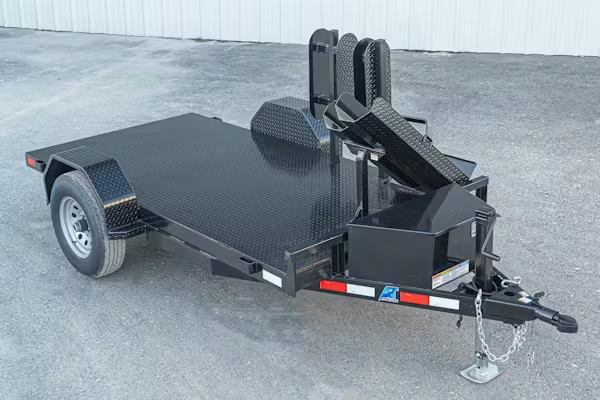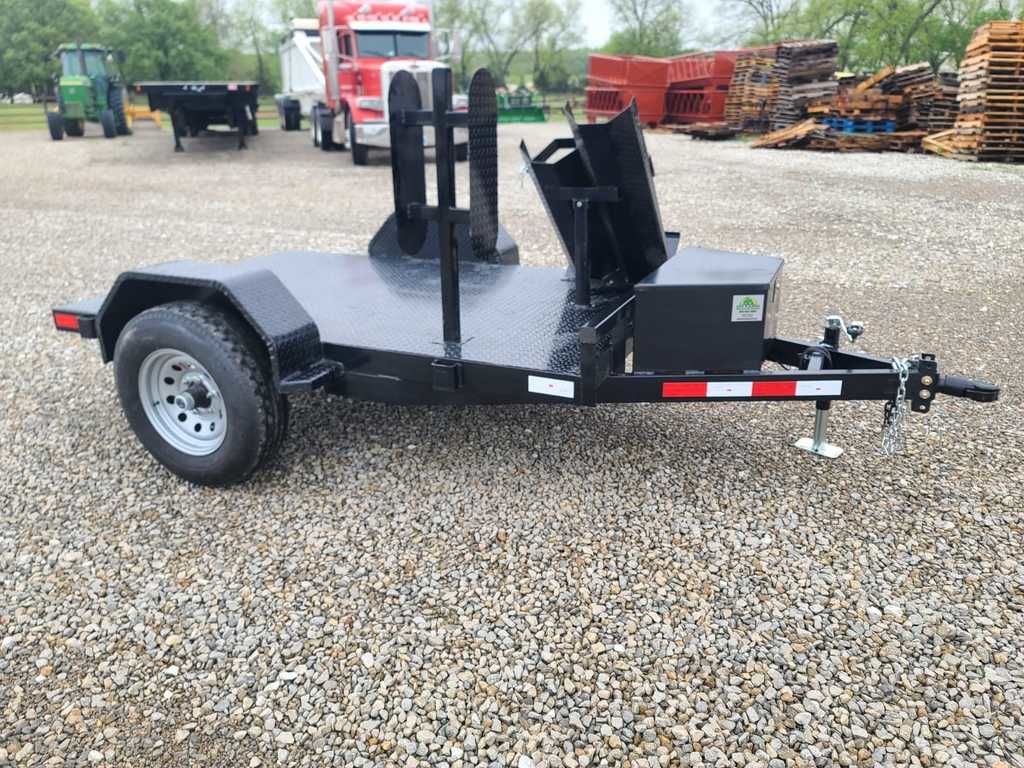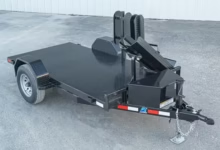
A welding trailer is more than just a utility hauler; it’s a mobile workstation built to meet the rugged demands of welders who need to take their craft on the road. Whether you’re an independent contractor, a farm operator, or someone running a fabrication business, a welding trailer can be your most valuable asset. From securely hauling gas tanks and equipment to providing an organized workspace with everything in arm’s reach, a welding trailer transforms the way welders operate in the field.
In this guide, we’ll break down what a welding trailer is, what features you should look for, how to build or buy one, and why they’ve become essential in various industries. This isn’t just a utility—it’s your portable welding shop.
What Is a Welding Trailer?

A welding trailer is a mobile unit specifically designed to carry all the tools and equipment a welder needs. Unlike general-purpose trailers, welding trailers are outfitted with mounts, racks, compartments, and even power systems tailored to support welding operations.
They often include:
- Secure gas bottle holders
- Generator or welder mounts
- Tool storage compartments
- Workbenches or flat surfaces
- Hose reels and cable hangers
Some trailers are fully custom builds, while others are modified from flatbeds or utility trailers. The purpose is the same: deliver efficiency and mobility for professional and hobby welders alike.
Benefits of Using a Welding Trailer
Welding trailers offer a range of benefits that make them a practical solution for welders on the go:
- Mobility: Get your equipment to any job site, whether it’s a remote farm, a construction site, or an urban job.
- Organization: Custom racks and compartments keep tools accessible and safe.
- Safety: Secure mounts reduce the risk of gas tank tipping or cable damage.
- Professional Appearance: A well-built trailer speaks volumes about your business.
Whether you’re operating a one-man welding business or managing a team, a welding trailer optimizes your workflow.
Types of Welding Trailers
Not all welding trailers are built the same. Depending on your needs, you might opt for one of the following types:
Single-Axle Welding Trailers
Ideal for light to moderate use. These are easier to maneuver and great for tight job sites.
Dual-Axle Welding Trailers
Built for heavy-duty setups. With more stability and load capacity, these trailers are better suited for carrying large welders, multiple gas bottles, and extra tools.
Flatbed Welding Trailers
Highly customizable. These trailers start as an open flatbed and can be outfitted with toolboxes, welder mounts, and racks to fit your specific needs.
Enclosed Welding Trailers
Great for security and protection against the elements. While less common, some welders prefer an enclosed unit to protect expensive gear.
Essential Components of a Welding Trailer
To operate efficiently, a welding trailer should include several key components:
Welder or Generator Mount
Most trailers feature a dedicated area to securely hold a welding machine or generator. It’s often bolted down for safety and accessibility.
Gas Cylinder Holders
Secure upright holders are necessary for transporting oxygen, acetylene, or other gases. Chains or straps keep the bottles in place.
Tool Storage
Custom drawers or lockable tool boxes protect your gear and keep it organized. Some trailers even include pegboard panels or foam-cut organizers.
Cable and Hose Management
Reels or hangers prevent tangles and extend the life of your leads and hoses. Efficient cable management improves safety, too.
Work Surface
A small bench or fold-out table can act as an on-site workstation, giving you a clean surface for prep or light repairs.
Lighting
LED work lights or spotlights are useful for night jobs or poorly lit areas. Many trailers now feature solar-powered lighting systems.
How to Build Your Welding Trailer

If you’re a DIY enthusiast or simply want a trailer tailored to your exact needs, building your welding trailer is a smart option.
Step 1: Choose a Base
Start with a strong frame. An old utility trailer, car hauler, or flatbed makes a great base. Make sure it’s rated for the load you plan to carry.
Step 2: Layout Planning
Sketch a layout including:
- Welder location
- Gas cylinder storage
- Toolboxes
- Hose reels
- Workbench area
Step 3: Fabrication
- Weld on brackets for gas bottles
- Add reinforcements for the welder mount
- Install lockable storage units
- Attach cable management systems
Step 4: Electrical Setup
Include wiring for lights or an inverter if you plan to power small devices. Install grounding points for safety.
Step 5: Paint and Finish
Protect your build with rust-resistant paint or powder coating. Add reflective tape and markers for road safety.
Buying a Welding Trailer: What to Look For
Buying a ready-made welding trailer is a great option if you’re short on time or fabrication resources.
Key Buying Considerations:
- Weight Capacity: Make sure the axle rating suits your load
- Storage Options: Check for customizable compartments
- Towing Compatibility: Ensure it matches your vehicle’s towing specs
- Material Quality: Look for solid welds, weatherproofing, and durable paint
Average Price Range:
TypePrice Range
Basic Single-Axle $1,500 – $3,000
Custom Dual-Axle $3,000 – $7,500
Fully Enclosed $5,000 – $10,000+
The investment pays off in mobility, organization, and job site efficiency.
Customizing Your Welding Trailer
Customization makes your trailer uniquely suited to your needs. Here are popular upgrades:
- Solar panels with battery banks
- Onboard air compressors
- Weatherproof storage compartments
- Fold-out benches or vises
- Built-in first aid kits
Your welding trailer should work as hard as you do. Customizations help you save time, avoid frustration, and deliver better results.
Welding Trailer Safety Tips
Using a welding trailer comes with responsibilities. Here are key safety practices:
- Always secure gas cylinders in an upright position
- Check tire pressure and lug nuts before traveling
- Never overload the trailer beyond its axle rating
- Keep fire extinguishers accessible
- Regularly inspect welds and structural components for cracks or rust
Safe practices not only prevent accidents—they protect your investment and reputation.
Maintenance Checklist
Keep your welding trailer in top condition with a regular maintenance routine:
- Check tires and wheel bearings monthly
- Inspect welds and frame joints every 3 months
- Test lighting and wiring bi-monthly
- Clean tool storage and clear debris weekly
- Lubricate moving parts as needed
Preventive maintenance reduces costly repairs and downtime.
Industries That Rely on Welding Trailers
Welding trailers aren’t just for welding contractors. They’re used across many sectors:
- Agriculture: On-site repairs for machinery and fencing
- Construction: Steel frame erection and structural jobs
- Oil & Gas: Pipeline and rig maintenance
- Manufacturing: Field fabrications and modifications
- Utilities: Emergency repairs and service installations
Wherever metal needs joining, welding trailers bring the workshop to the job site.
Welding Trailer Tags and SEO Keywords
Throughout your blog or ecommerce platform, these SEO-friendly tags and keywords can boost discoverability:
- Welding trailer
- Mobile welding setup
- Custom welding rig
- Welding utility trailer
- Field welding tools
- Welding trailer for sale
- Build a welding trailer
- Portable welding workstation
- Welding truck and trailer combo
- Fabrication trailer
Use them wisely across product descriptions, metadata, and headings for the best SEO impact.
FAQs About Welding Trailers
Can I use a regular utility trailer for welding?
Yes, but modifications are necessary. You’ll need secure mounts for gas tanks, tool storage, and a welder platform. It’s not plug-and-play.
How much weight can a welding trailer carry?
It depends on the axle configuration. Single-axle trailers typically carry 2,000 to 3,500 lbs. Dual-axle trailers go up to 7,000+ lbs.
Are welding trailers street legal?
Yes, as long as they comply with road safety standards: lights, reflectors, brakes (if over 3,000 lbs), and registration.
Is a welding trailer better than a welding truck?
It depends on your workflow. A trailer is easier to detach and use across different vehicles, while a welding truck is more compact but less flexible.
Can I finance a welding trailer?
Many equipment retailers and banks offer financing options. Check interest rates and repayment terms before committing.
Final Thoughts
A welding trailer isn’t just a convenience—it’s a cornerstone of field welding efficiency. Whether you’re just starting or scaling your welding business, having a mobile setup can be a total game changer. From enhanced safety to improved productivity and professionalism, a well-equipped welding trailer will help you deliver top-notch service wherever the job takes you.
Whether you’re building one from scratch or investing in a pre-built rig, make sure your welding trailer fits your needs, your workflow, and your ambitions.
Need help choosing the right welding trailer for your business or side hustle? Drop a comment below or check out our next guide on “DIY Welding Trailer Plans That Work.”





